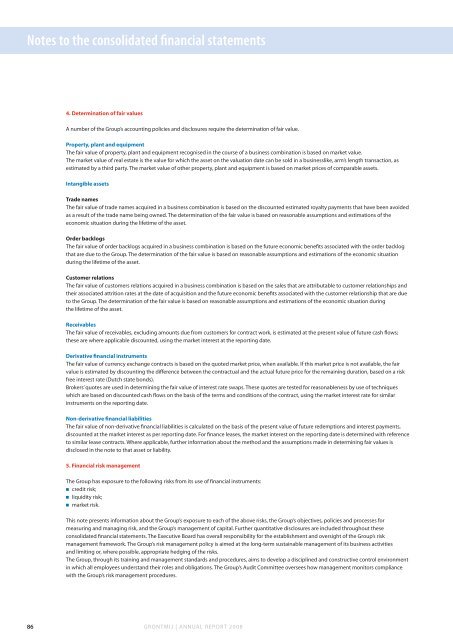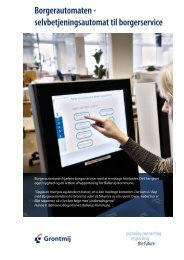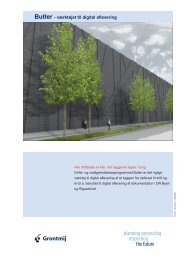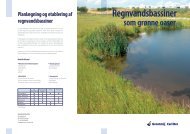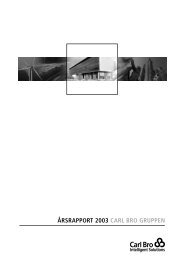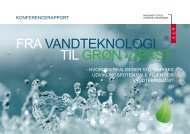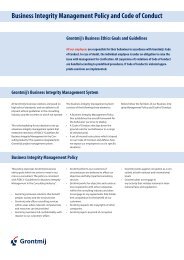Annual Report 2008 Sustainable design & engineering - Grontmij
Annual Report 2008 Sustainable design & engineering - Grontmij
Annual Report 2008 Sustainable design & engineering - Grontmij
Create successful ePaper yourself
Turn your PDF publications into a flip-book with our unique Google optimized e-Paper software.
Notes to the consolidated financial statements<br />
4. Determination of fair values<br />
A number of the Group’s accounting policies and disclosures require the determination of fair value.<br />
Property, plant and equipment<br />
The fair value of property, plant and equipment recognised in the course of a business combination is based on market value.<br />
The market value of real estate is the value for which the asset on the valuation date can be sold in a businesslike, arm’s length transaction, as<br />
estimated by a third party. The market value of other property, plant and equipment is based on market prices of comparable assets.<br />
Intangible assets<br />
Trade names<br />
The fair value of trade names acquired in a business combination is based on the discounted estimated royalty payments that have been avoided<br />
as a result of the trade name being owned. The determination of the fair value is based on reasonable assumptions and estimations of the<br />
economic situation during the lifetime of the asset.<br />
Order backlogs<br />
The fair value of order backlogs acquired in a business combination is based on the future economic benefits associated with the order backlog<br />
that are due to the Group. The determination of the fair value is based on reasonable assumptions and estimations of the economic situation<br />
during the lifetime of the asset.<br />
Customer relations<br />
The fair value of customers relations acquired in a business combination is based on the sales that are attributable to customer relationships and<br />
their associated attrition rates at the date of acquisition and the future economic benefits associated with the customer relationship that are due<br />
to the Group. The determination of the fair value is based on reasonable assumptions and estimations of the economic situation during<br />
the lifetime of the asset.<br />
Receivables<br />
The fair value of receivables, excluding amounts due from customers for contract work, is estimated at the present value of future cash flows;<br />
these are where applicable discounted, using the market interest at the reporting date.<br />
Derivative financial instruments<br />
The fair value of currency exchange contracts is based on the quoted market price, when available. If this market price is not available, the fair<br />
value is estimated by discounting the difference between the contractual and the actual future price for the remaining duration, based on a risk<br />
free interest rate (Dutch state bonds).<br />
Brokers’ quotes are used in determining the fair value of interest rate swaps. These quotes are tested for reasonableness by use of techniques<br />
which are based on discounted cash flows on the basis of the terms and conditions of the contract, using the market interest rate for similar<br />
instruments on the reporting date.<br />
Non-derivative financial liabilities<br />
The fair value of non-derivative financial liabilities is calculated on the basis of the present value of future redemptions and interest payments,<br />
discounted at the market interest as per reporting date. For finance leases, the market interest on the reporting date is determined with reference<br />
to similar lease contracts. Where applicable, further information about the method and the assumptions made in determining fair values is<br />
disclosed in the note to that asset or liability.<br />
5. Financial risk management<br />
The Group has exposure to the following risks from its use of financial instruments:<br />
o credit risk;<br />
o liquidity risk;<br />
o market risk.<br />
This note presents information about the Group’s exposure to each of the above risks, the Group’s objectives, policies and processes for<br />
measuring and managing risk, and the Group’s management of capital. Further quantitative disclosures are included throughout these<br />
consolidated financial statements. The Executive Board has overall responsibility for the establishment and oversight of the Group’s risk<br />
management framework. The Group’s risk management policy is aimed at the long-term sustainable management of its business activities<br />
and limiting or, where possible, appropriate hedging of the risks.<br />
The Group, through its training and management standards and procedures, aims to develop a disciplined and constructive control environment<br />
in which all employees understand their roles and obligations. The Group’s Audit Committee oversees how management monitors compliance<br />
with the Group’s risk management procedures.<br />
86<br />
GRONTMIJ | ANNUAL REPORT <strong>2008</strong>


